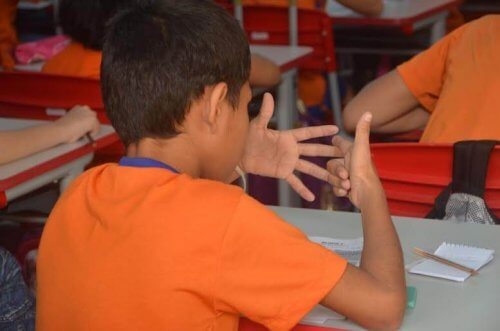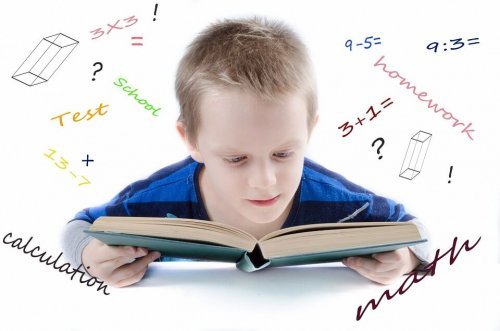Tricks for Teaching Children How to Multiply

However, this is definitely not always the case. For some children, math is an enormous challenge.
Once children learn how to add and subtract, then they’re ready to incorporate a new mathematical ability: multiplication.
Knowing how to multiply will be a useful skill throughout their education, and for the rest of their life.
However, learning to multiply isn’t always easy. So what can we do to help our children?
Advice for teaching children how to multiply
Is it time for you to teach this complex procedure to a child? Here are some recommendations that will make it easier for both of you:
1. Explain the reasoning behind multiplication
Like so many other aspects of life, telling someone what to do isn’t enough. Explaining why something should be done in a certain way is much more effective.
For example, you can show the child that multiplication is a shortcut for carrying out complex or successive sums.
If children can appreciate the value and logic of multiplication, they’ll have an easier time learning it.
Furthermore, this will motivate them to try to understand the concept. Children possess a natural passion for learning, even though it doesn’t always seem that way.
Therefore, knowing more about why this process is so important in life will make learning more attractive.
2. Don’t begin with multiplication tables
If your child is having a hard time understanding what multiplication is all about, the worse thing you can do is torture him with a table full of numbers.
It’s better to start out with isolated equations.
Practice with simple equations such as 2×2, 2×3, 3×3, etc. Once your child has mastered these, you can move onto higher numbers.
Tip: Help your child understand the “times” part of the operation. For example, “five times three” is the same as “five, three times.”
If your child can understand this concept, multiplying will come much easier.

3. Practice makes perfect
There is a lot of truth behind this age-old saying: practice makes perfect. Learning to multiply is no exception to the rule.
Many times the academic environment isn’t the best place for teaching children how to multiply.
Therefore, if parents want their children to succeed, they must set aside time every day to help their children practice.
4. Use multiplication tables
Multiplication tables – or times tables – can be very useful in helping your child think about multiplication from another angle.
These tools clearly demonstrate the commutative property of multiplication. In other words, 5×3 is equal to 3×5.
At first sight, this may seem extremely difficult to understand.
However, with patience and dedication, your child can learn to correct her own work with the help of this instrument.
5. Make use of memory
When it comes to understanding multiplication tables, thinking about them in another way is very effective.
What do we mean by that? Teach your child that when multiplying with zero (0), the result is always zero.
Also, when multiplying by 1, the result is always the same as the other number (1×7=7).
When multiplying by 2, the result is double of the other number. You can point out that when multiplying by 5, the results increment by 5 (5, 10, 15, etc).
Another secret you can reveal to your child is that when multiplying by 10, you simply add a zero to the end of the number being multiplied.
“The worse thing you can do is torture him with a table full of numbers. It’s better to start out with isolated equations”
6. Use songs, games and stories
This is a perfect complement to the previous tip. There are many didactic songs available online to help pass math skills on from generation to generation.
You can also find games on the internet to make learning easier and more fun.
Finally, you can use the famous tale of Robin Hood to teach children how to multiply by 9.
Tell your child how Robin Hood would steal from the rich (left digit, or “the tens place”) to give to the poor (right digit, or “the ones place”) as the table advances.
In other words, as the the number on the left gets lower, the number on the right gets higher.

Further recommendations
It’s important to clarify that you should wait until the right time to teach multiplication to elementary school students.
If a child isn’t ready, then he’ll only become frustrated and perhaps even develop an aversion to mathematics.
At the same time, remember to always be patient and caring when teaching your child.
Don’t lose control when things get tough or criticize your child’s attempts. Rather, give your child positive feedback and value her progress.
That way, your child’s confidence and enthusiasm will increase, and the learning experience will be more effective and tolerable.
However, this is definitely not always the case. For some children, math is an enormous challenge.
Once children learn how to add and subtract, then they’re ready to incorporate a new mathematical ability: multiplication.
Knowing how to multiply will be a useful skill throughout their education, and for the rest of their life.
However, learning to multiply isn’t always easy. So what can we do to help our children?
Advice for teaching children how to multiply
Is it time for you to teach this complex procedure to a child? Here are some recommendations that will make it easier for both of you:
1. Explain the reasoning behind multiplication
Like so many other aspects of life, telling someone what to do isn’t enough. Explaining why something should be done in a certain way is much more effective.
For example, you can show the child that multiplication is a shortcut for carrying out complex or successive sums.
If children can appreciate the value and logic of multiplication, they’ll have an easier time learning it.
Furthermore, this will motivate them to try to understand the concept. Children possess a natural passion for learning, even though it doesn’t always seem that way.
Therefore, knowing more about why this process is so important in life will make learning more attractive.
2. Don’t begin with multiplication tables
If your child is having a hard time understanding what multiplication is all about, the worse thing you can do is torture him with a table full of numbers.
It’s better to start out with isolated equations.
Practice with simple equations such as 2×2, 2×3, 3×3, etc. Once your child has mastered these, you can move onto higher numbers.
Tip: Help your child understand the “times” part of the operation. For example, “five times three” is the same as “five, three times.”
If your child can understand this concept, multiplying will come much easier.

3. Practice makes perfect
There is a lot of truth behind this age-old saying: practice makes perfect. Learning to multiply is no exception to the rule.
Many times the academic environment isn’t the best place for teaching children how to multiply.
Therefore, if parents want their children to succeed, they must set aside time every day to help their children practice.
4. Use multiplication tables
Multiplication tables – or times tables – can be very useful in helping your child think about multiplication from another angle.
These tools clearly demonstrate the commutative property of multiplication. In other words, 5×3 is equal to 3×5.
At first sight, this may seem extremely difficult to understand.
However, with patience and dedication, your child can learn to correct her own work with the help of this instrument.
5. Make use of memory
When it comes to understanding multiplication tables, thinking about them in another way is very effective.
What do we mean by that? Teach your child that when multiplying with zero (0), the result is always zero.
Also, when multiplying by 1, the result is always the same as the other number (1×7=7).
When multiplying by 2, the result is double of the other number. You can point out that when multiplying by 5, the results increment by 5 (5, 10, 15, etc).
Another secret you can reveal to your child is that when multiplying by 10, you simply add a zero to the end of the number being multiplied.
“The worse thing you can do is torture him with a table full of numbers. It’s better to start out with isolated equations”
6. Use songs, games and stories
This is a perfect complement to the previous tip. There are many didactic songs available online to help pass math skills on from generation to generation.
You can also find games on the internet to make learning easier and more fun.
Finally, you can use the famous tale of Robin Hood to teach children how to multiply by 9.
Tell your child how Robin Hood would steal from the rich (left digit, or “the tens place”) to give to the poor (right digit, or “the ones place”) as the table advances.
In other words, as the the number on the left gets lower, the number on the right gets higher.

Further recommendations
It’s important to clarify that you should wait until the right time to teach multiplication to elementary school students.
If a child isn’t ready, then he’ll only become frustrated and perhaps even develop an aversion to mathematics.
At the same time, remember to always be patient and caring when teaching your child.
Don’t lose control when things get tough or criticize your child’s attempts. Rather, give your child positive feedback and value her progress.
That way, your child’s confidence and enthusiasm will increase, and the learning experience will be more effective and tolerable.
All cited sources were thoroughly reviewed by our team to ensure their quality, reliability, currency, and validity. The bibliography of this article was considered reliable and of academic or scientific accuracy.
- Rodrigo-Huete, N. (2017). Enseñar a multiplicar mediante el juego y el aprendizaje cooperativo (Bachelor’s thesis). https://reunir.unir.net/handle/123456789/4777
- Almache Tello, D. A. (2013). Aporte de nuevos métodos y técnicas para facilitar el aprendizaje de las tablas de multiplicar en los niños del cuarto, quinto, sexto y séptimo años de educación básica de la escuela―buenos aires‖ del cantón azogues (Bachelor’s thesis). https://repositorio.uta.edu.ec/handle/123456789/3610
- Muñoz Ortíz, C. L. (2010). Estrategias didácticas para desarrollar el aprendizaje significativo de las tablas de multiplicar en niños del grado 3–B de la Institución Educativa José Holguín Garcés–sede Ana María de Lloreda (Bachelor’s thesis, Universidad de La Sabana). https://intellectum.unisabana.edu.co/handle/10818/1453
This text is provided for informational purposes only and does not replace consultation with a professional. If in doubt, consult your specialist.








